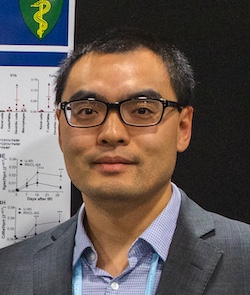UKidney Nephrology News and Insights
Adaptive and maladaptive kidney repair models reveal distinct pathways of myeloid and lymphoid cell recruitment and activation
Presenter: Leyuan Xu, PhD, Yale University
Authors: Leyuan Xu, PhD, Yale University, Lloyd G. Cantley MD, FASN, Yale University School of Medicine
 Leyuan XuAbnormal accumulation of macrophages, dendritic cells, and T cells may lead to progressive interstitial fibrosis, sustained inflammation, and kidney injury in the setting of maladaptive kidney repair following IRI. Blocking homing chemokines may serve as a therapeutic target to attenuate CKD progression.
Leyuan XuAbnormal accumulation of macrophages, dendritic cells, and T cells may lead to progressive interstitial fibrosis, sustained inflammation, and kidney injury in the setting of maladaptive kidney repair following IRI. Blocking homing chemokines may serve as a therapeutic target to attenuate CKD progression.
This conclusion followed a hypothesis that incomplete repair after acute kidney injury (AKI) can lead to progressive fibrosis and development of chronic kidney disease (CKD). The poster authors have previously shown that unilateral ischemia-reperfusion kidney injury with contralateral nephrectomy (IRI/CL-NX) results in significantly less fibrosis in the injured kidney than does unilateral IRI with the contralateral kidney intact (U-IRI). That led to investigating the mechanism of this difference by comparing an identical time of ischemic injury between mice subjected to U-IRI and those subjected to IRI/CL-NX.
Analysis results revealed that initial recruitment and activation of macrophages, dendritic cells, and T cells, as well as myofibroblast activation and profibrotic gene expression, were equivalent through day 7 in these two models. However, in the IRI/CL-NX model, macrophage numbers declined after day 7 with tubule regeneration and only modest interstitial fibrosis on day 30. In contrast, macrophages persisted and expressed significantly higher levels of profibrotic growth factors Pdgfb and Tgfb1, while dendritic cells and T cells significantly increased in numbers and expressed greater amounts of Tnfa and Il1b.
These sustained immune responses correlated with progressive expression of collagen and fibronectin, sustained expression of Havcr1 and Lcn2, less tubule regeneration, and greater kidney atrophy. The persistence of macrophages, dendritic cells, and T cells in injured U-IRI kidneys highly correlated with sustained expression of the chemokines Ccl1, Ccl2 and Cx3cl1.

